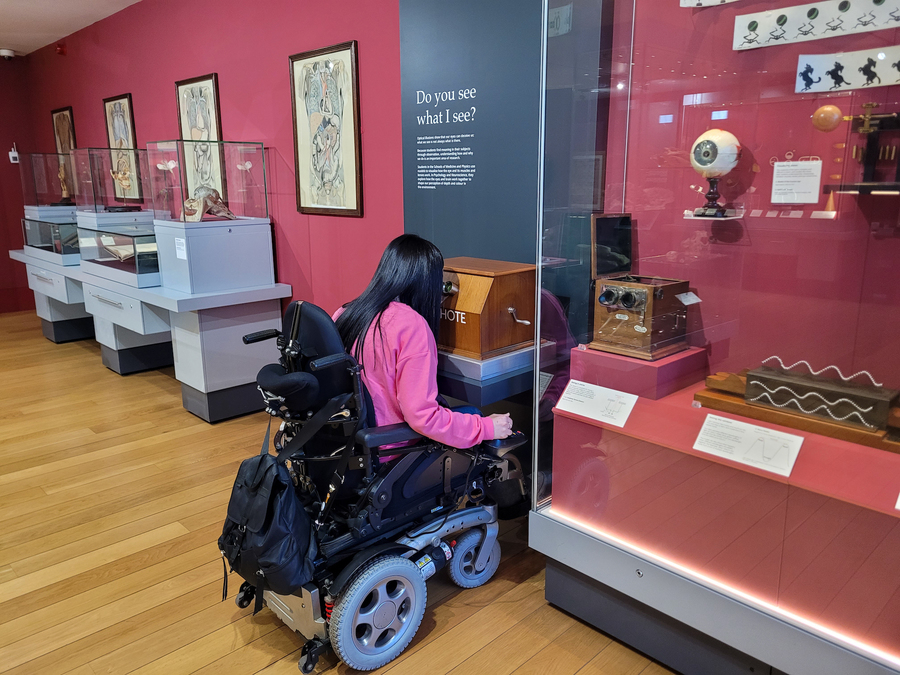Get Inspired by Scotland's Museums and Galleries
Scotland has a wealth of museums and galleries that offer fun, educational and affordable days out. To get you inspired, we spoke to leading accessible travel blogger Emma Muldoon about her recent visits to two great museums in Fife

If you’re looking for fun and enlightening places to visit this summer that won’t break the bank, you can’t do much better than exploring one of the 450 museums and galleries across Scotland. From mighty institutions like Kelvingrove Art Gallery and Museum in Glasgow and the National Museum of Scotland in Edinburgh, to quirkier places of interest like the Jim Clark Motorsport Museum in Duns and the Museum of Scottish Lighthouses in Fraserburgh, there’s a whole host to choose from, big and small, across the country.
One thing people might take for granted when planning a trip to a Scottish museum, however, is how accessible these buildings are, especially considering many of them were built centuries ago. It’s a question that’s often on the mind of Emma Muldoon, who’s one of the UK’s leading accessible travel and disability bloggers. “My partner and I both love to travel,” Emma tells us, “but unfortunately, like many disabled people, we’ve faced our fair share of challenges and a lack of accessibility when travelling and in general day-to-day.”
Emma uses a power wheelchair to get around, and a particularly bad experience on a trip to New York nine years ago motivated her to raise awareness of the issues she faces when travelling and explore ways to bring about positive change. “I [started my blog] to share my own experiences and honest insights to encourage and empower other disabled people to explore the world,” she explains, “because there is so much to see and experience and special memories to be made along the way.”
Recently Emma took a trip to Fife, visiting two hidden gems on the east coast: The Scottish Fisheries Museum in Anstruther and Wardlaw Museum in St Andrews. But how accessible were they?
When Emma arrived at the former, it didn’t look promising. It’s an old building and at first glance from the outside, it gave the impression of being small. “Wheelchair users like myself often encounter poor accessibility in such buildings,” says Emma. Looks can be deceiving, though. To Emma’s surprise, The Scottish Fisheries Museum proved positively Tardis-like. “The museum is actually quite spacious inside,” she explains, “with exhibitions spread across two floors that offer a fascinating glimpse into Scotland’s fishing industry.”
The museum has an online access guide, which Emma read before the visit. “I was impressed with how much detail it provided,” she says. The guide gave her a vital overview of what she could expect in terms of accessibility, in particular around access to the galleries and the accessible toilet. “Knowing this information prior to my visit made me confident that my needs would be met.”
Getting around the building proved relatively easy thanks to ramps that have been seamlessly integrated into the architecture. “It’s such an old building, and obviously, accessibility wouldn’t have been a consideration when it was originally built, so it’s great to see access for disabled visitors being implemented and regularly improved,” she says. “The only non-accessible gallery is The Fisherman’s Cottage, but it can still be viewed through an accessible window.”
It’s fair to say Emma enjoyed her trip. “The Scottish Fisheries Museum is a treasure trove of historic displays and memorabilia, with room after room filled to the brim with fascinating artefacts,” she says. “We were particularly interested in learning about the lives of fishing families and towns from years gone by, right up to more recent times.”

Emma at the Wardlaw Museum, St Andrews. Photo by Emma Muldoon, @SimplyEmmaBlog on Instagram
Later that same day, Emma visited Wardlaw Museum at St Andrews University, which offers a glimpse into the history and impact of Scotland’s first university, founded in 1413. Once again, she found a detailed access guide on the muse- um’s website, which gave her tonnes of useful information. In terms of accessibility, she found The Wardlaw Museum to be excellent. “The galleries are located on the ground floor, providing ample space for me to move around in my wheelchair,” she says, “The displays were also at a suitable height for wheelchair users. For access to the upper floor, a lift is available, leading to the Learning Loft and Research Studio. The upper floor also provides access to the roof terrace, which is a must-see.”
While Emma found both museums easy to navigate, she says it’s important to note that “there is no such thing as a place that is fully accessible”, given that each disabled person has specific accessibility needs. That’s why having detailed accessibility information online is so important. “What matters most is factual data that allows us to make informed choices,” she says. “That’s why I confidently visited both the Scottish Fisheries Museum and the Wardlaw Museum, as their websites offer detailed access guides that allowed me to decide if they would meet my access needs.”
If you’re interested in visiting one of Scotland’s 450 museums and galleries but are concerned about accessibility, be sure to check out their accessibility guides online first. “If that’s not available, you can always reach out to the specific museum or gallery to enquire about their accessibility accommodations,” notes Emma. “From my experience, museums and galleries across Scotland strive to be accessible to all visitors.” For a list of Scottish museums or galleries to visit in your local area or beyond, take a look at Museums Galleries Scotland’s interactive map at museumsgalleriesscotland.org.uk/museums-are-go/
To find out more about Emma’s trip to The Scottish Fisheries Museum and Wardlaw Museum, check out Emma’s YouTube (youtube.com/@SimplyEmma) and Instagram (instagram.com/simplyemmablog)
